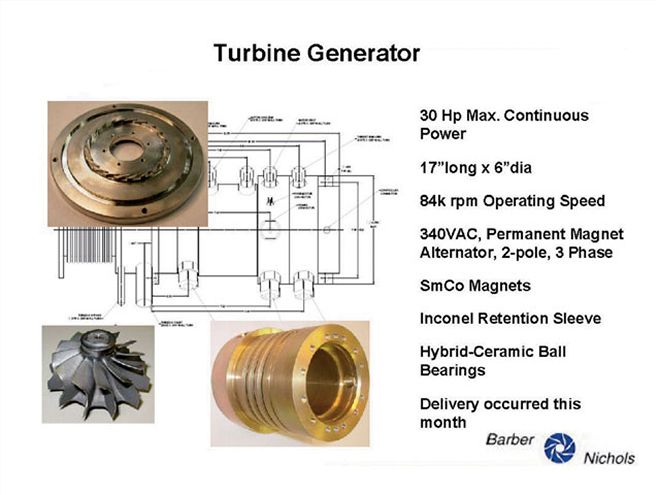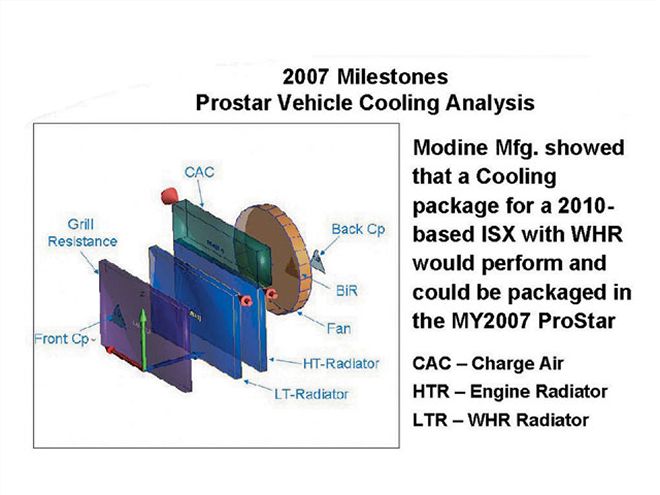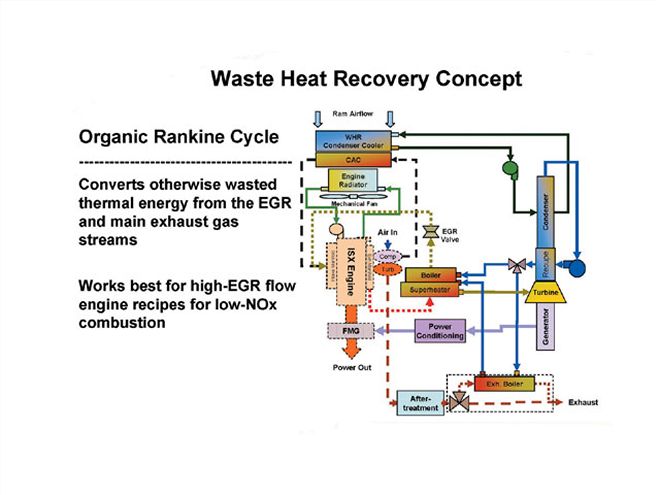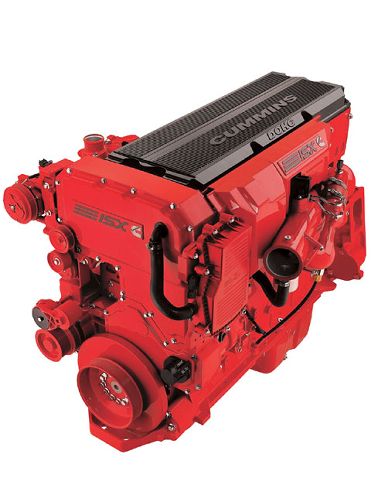
| cummins Isx Diesel Engine sample Engine
Cummins is developing an engine system that will increase fuel efficiency by 10%. The test bed is the 14.9L ISX. The ISX debuted in 1998 and features EGR, dual overhead cams (one for the fuel system and the other for the valves and brake system), and a variable geometry turbo. None of these will need any fundamental changes in order to accommodate Cummins' radically new experiment, which will be available as early as 2013. The technology will reduce the size of the radiator and multiple coolers-a smaller cooling system means better aerodynamics. Losses due to powering the truck's alternator and various pumps will also be a thing of the past. Another benefit of this scheme is that it creates cooled air for the engine. A Class 8 truck with this engine setup will likely save 1,800 gallons of fuel per year. Less emissions is also a benefit due to less fuel consumption. The most powerful production ISX produces 565 hp and 1,850 lb-ft of torque. After the engineers' extensive modifications, these numbers are going to get bigger.
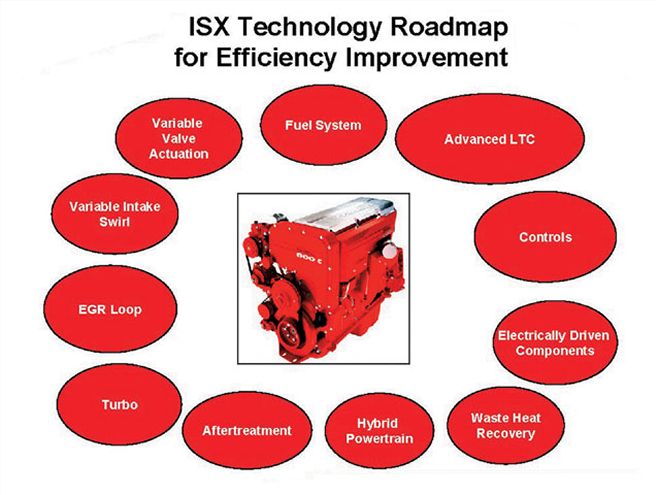
| In order to increase fuel efficiency, Cummins relies on a number of technologies like a variable geometry turbo, variable valve actuation, and even steam power from waste heat.
How is this possible?You might be asking yourself if this technology involves a brand-new development in quantum physics? Nope, it will use steam. Cummins is adapting a technology traditionally used in electric powerplants called the Organic Rankine Cycle (ORC). The addition of this process to the diesel engine is a change in perspective. Instead of looking at heat as the enemy, it is now viewed as a helpful friend. High exhaust gas recirculation (EGR) temperature turns from being a problem into a solution. The heat (energy) comes out of the engine and then goes into a superheater. This device superheats the wet steam (from the boiler) into dry superheated steam (steam heated beyond boiling). The dry steam has massive amounts of energy and turns a turbine. The turbine turns a generator and transforms otherwise wasted heat energy into usable electric energy. Cummins has decided to use its electricity to power an electric motor built into the crankshaft. Once the superheated steam transfers its energy into the turbine, it is condensed and routed back into the system producing a complete cycle.
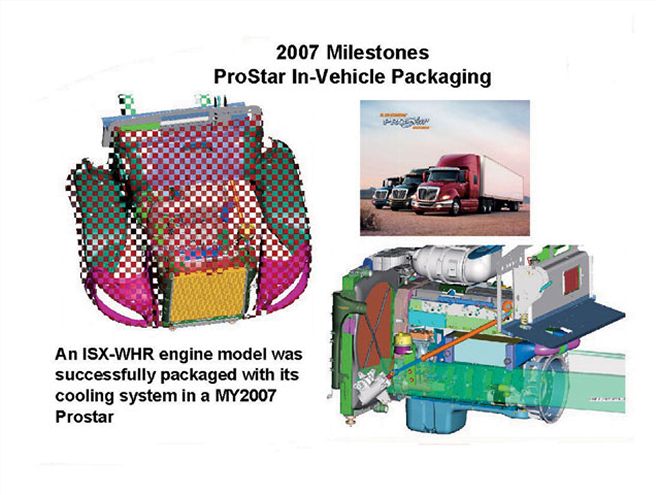
| This Cummins prototype uses a piggybacked steam engine to recover the heat most engines let escape as waste.
Boiling this article down to its main point, Cummins went from just using internal combustion to using both internal and external combustion. Remember, this is a concept limited to 14.9L engines only. However, if fuel prices stay high, it may only be a matter of time before we start writing articles on upgrading condensers, boilers, and turbines. Who knows, if it works it could trickle down to the 6.7L found in Dodge Rams.
Where Will the Extra Energy Come From?+6%from EGR energy
+2%from exhaust energy
+2%from the eliminationof parasitic accessories
=10%overall improvementthroughout drive cycle
Here are some facts:Thermodynamics - Laws which describe the connections between heat and mechanical energy.
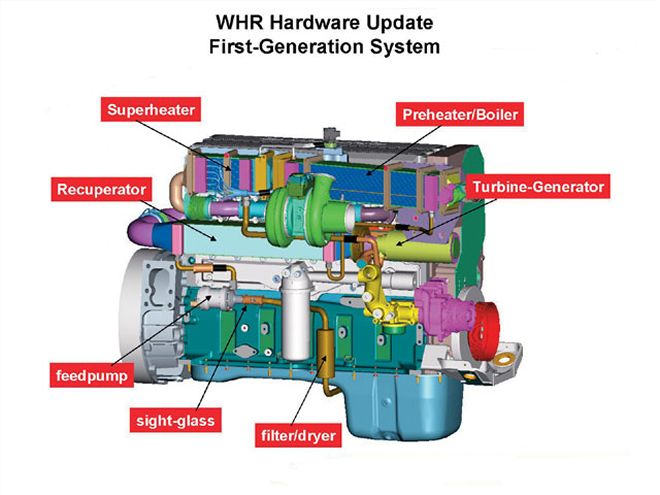
| Old is mixed with new. Most of the parts are recognizable. For example, the engine block, oil pan, turbo, valve cover, and harmonic balancer haven't changed. The highlighted components are fitted in a way that makes them look like they belong.
1. The first law of thermodynamics states energy can neither be created nor destroyed, but just changes its form.
2.Diesel fuel is a form of potential energy that we store in our fuel tanks. As it combusts inside the engine, a chemical reaction takes place and the energy changes forms and becomes kinetic energy. Some of this kinetic energy is used to drive the wheels, but most of it is lost as heat.
3. A gallon of diesel fuel contains 139,000 Btu of potential energy.
4. One British Thermal Unit (Btu) is the amount of heat required to increase one pound of water one degree Fahrenheit.
5. Peak Thermal Efficiency equals the work you get, divided by what you put in. A gasoline-powered car is around 25 percent and a heavy-duty diesel engine is about 40-percent efficient. This means that if a truck has 100 gallons of fuel in the tank, only 40 gallons are used to drive the wheels. The other 60 gallons are wasted. Where do the other 60 gallons go though?
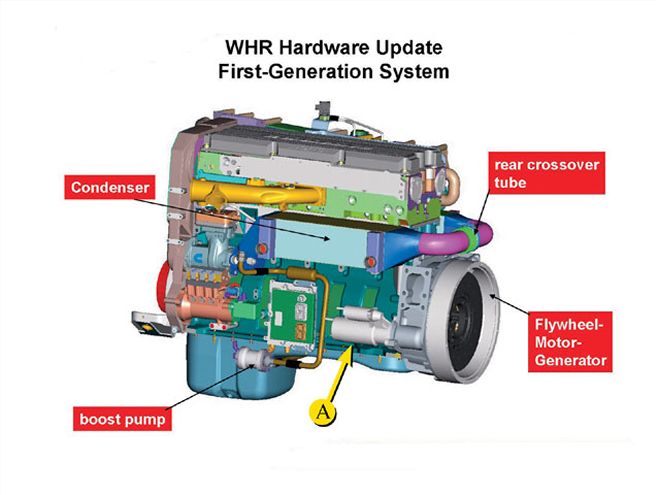
| cummins Isx Diesel Engine first Generation System
Consider ThisOnly 1/3 of the potential energy in a gallon of fuel goes into moving consumer vehicles. The rest is waste. Why put up with this? In no other area of a normal person's life is this much waste acceptable. Imagine only using 33% of a paycheck or only drinking a third of a favorite refreshing beverage. Where does the rest go? Since energy is neither created nor destroyed, the remaining waste turns into sound and heat.
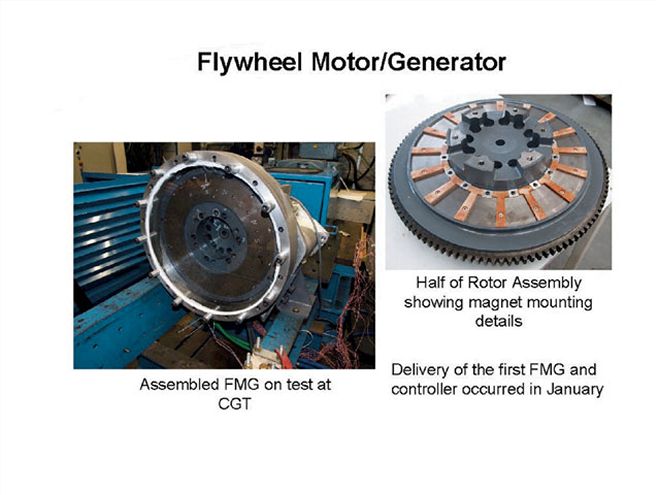
| cummins Isx Diesel Engine flywheel Generator
Two Types of Energy1. Waste EnergyAn example of waste energy is when your truck tries to heat the great outdoors. Your heaters include the radiator, the engine itself, transmission, transfer case, U-joints, differentials, brakes, various coolers, and basically anything that gets hotter than the outside air. Let's not forget your heater. Noise is also in this category. Remember that noise and heat are both forms of energy. Power that could have gone to your wheels is also turning your accessories like air conditioning, alternator, and power steering instead.
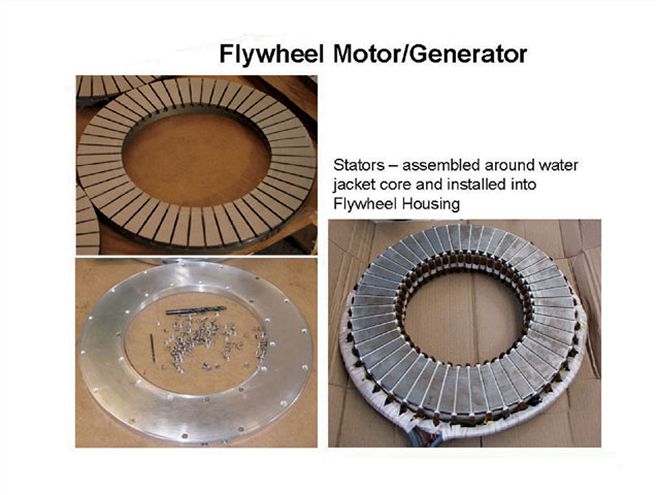
| cummins Isx Diesel Engine flywheel Motor
2. Work EnergyWork is the energy used to get you where you want to go. Let's say traffic breaks up and you start to move. Nothing is in your way, right? Wrong. Gravity or your own weight (inertia) are against you and must be constantly overcome. OK, now you're fine, right? Wrong. The wind is holding you back. What else? Your tires, although round and turning smoothly, are slightly dragging their feet-another force working against you. All of these problems must be dealt with if you want more bang for your buck. Is it possible to get 100% thermal efficiency? The second law of thermodynamics says no.
Fuel SavingsAccording to AVL Powertrain Engineering
If waste-heat temperatures are greater than 752 degrees F, it's possible to gain 15-20% of fuel efficiency.
At 18% efficiency:200,000 miles per year divided by 6 mpg x $3.15 per gallon = $105,000 per year
$105,000 per year x 0.18 = a savings of $18,900 per year
 | cummins Isx Diesel Engine sample Engine
Cummins is developing an engine system that will increase fuel efficiency by 10%. The test bed is the 14.9L ISX. The ISX debuted in 1998 and features EGR, dual overhead cams (one for the fuel system and the other for the valves and brake system), and a variable geometry turbo. None of these will need any fundamental changes in order to accommodate Cummins' radically new experiment, which will be available as early as 2013. The technology will reduce the size of the radiator and multiple coolers-a smaller cooling system means better aerodynamics. Losses due to powering the truck's alternator and various pumps will also be a thing of the past. Another benefit of this scheme is that it creates cooled air for the engine. A Class 8 truck with this engine setup will likely save 1,800 gallons of fuel per year. Less emissions is also a benefit due to less fuel consumption. The most powerful production ISX produces 565 hp and 1,850 lb-ft of torque. After the engineers' extensive modifications, these numbers are going to get bigger.
| cummins Isx Diesel Engine sample Engine
Cummins is developing an engine system that will increase fuel efficiency by 10%. The test bed is the 14.9L ISX. The ISX debuted in 1998 and features EGR, dual overhead cams (one for the fuel system and the other for the valves and brake system), and a variable geometry turbo. None of these will need any fundamental changes in order to accommodate Cummins' radically new experiment, which will be available as early as 2013. The technology will reduce the size of the radiator and multiple coolers-a smaller cooling system means better aerodynamics. Losses due to powering the truck's alternator and various pumps will also be a thing of the past. Another benefit of this scheme is that it creates cooled air for the engine. A Class 8 truck with this engine setup will likely save 1,800 gallons of fuel per year. Less emissions is also a benefit due to less fuel consumption. The most powerful production ISX produces 565 hp and 1,850 lb-ft of torque. After the engineers' extensive modifications, these numbers are going to get bigger.
 | In order to increase fuel efficiency, Cummins relies on a number of technologies like a variable geometry turbo, variable valve actuation, and even steam power from waste heat.
How is this possible?
| In order to increase fuel efficiency, Cummins relies on a number of technologies like a variable geometry turbo, variable valve actuation, and even steam power from waste heat.
How is this possible? | This Cummins prototype uses a piggybacked steam engine to recover the heat most engines let escape as waste.
Boiling this article down to its main point, Cummins went from just using internal combustion to using both internal and external combustion. Remember, this is a concept limited to 14.9L engines only. However, if fuel prices stay high, it may only be a matter of time before we start writing articles on upgrading condensers, boilers, and turbines. Who knows, if it works it could trickle down to the 6.7L found in Dodge Rams.
Where Will the Extra Energy Come From?+6%from EGR energy
+2%from exhaust energy
+2%from the eliminationof parasitic accessories
=10%overall improvementthroughout drive cycle
Here are some facts:
| This Cummins prototype uses a piggybacked steam engine to recover the heat most engines let escape as waste.
Boiling this article down to its main point, Cummins went from just using internal combustion to using both internal and external combustion. Remember, this is a concept limited to 14.9L engines only. However, if fuel prices stay high, it may only be a matter of time before we start writing articles on upgrading condensers, boilers, and turbines. Who knows, if it works it could trickle down to the 6.7L found in Dodge Rams.
Where Will the Extra Energy Come From?+6%from EGR energy
+2%from exhaust energy
+2%from the eliminationof parasitic accessories
=10%overall improvementthroughout drive cycle
Here are some facts: | Old is mixed with new. Most of the parts are recognizable. For example, the engine block, oil pan, turbo, valve cover, and harmonic balancer haven't changed. The highlighted components are fitted in a way that makes them look like they belong.
1. The first law of thermodynamics states energy can neither be created nor destroyed, but just changes its form.
2.Diesel fuel is a form of potential energy that we store in our fuel tanks. As it combusts inside the engine, a chemical reaction takes place and the energy changes forms and becomes kinetic energy. Some of this kinetic energy is used to drive the wheels, but most of it is lost as heat.
3. A gallon of diesel fuel contains 139,000 Btu of potential energy.
4. One British Thermal Unit (Btu) is the amount of heat required to increase one pound of water one degree Fahrenheit.
5. Peak Thermal Efficiency equals the work you get, divided by what you put in. A gasoline-powered car is around 25 percent and a heavy-duty diesel engine is about 40-percent efficient. This means that if a truck has 100 gallons of fuel in the tank, only 40 gallons are used to drive the wheels. The other 60 gallons are wasted. Where do the other 60 gallons go though?
| Old is mixed with new. Most of the parts are recognizable. For example, the engine block, oil pan, turbo, valve cover, and harmonic balancer haven't changed. The highlighted components are fitted in a way that makes them look like they belong.
1. The first law of thermodynamics states energy can neither be created nor destroyed, but just changes its form.
2.Diesel fuel is a form of potential energy that we store in our fuel tanks. As it combusts inside the engine, a chemical reaction takes place and the energy changes forms and becomes kinetic energy. Some of this kinetic energy is used to drive the wheels, but most of it is lost as heat.
3. A gallon of diesel fuel contains 139,000 Btu of potential energy.
4. One British Thermal Unit (Btu) is the amount of heat required to increase one pound of water one degree Fahrenheit.
5. Peak Thermal Efficiency equals the work you get, divided by what you put in. A gasoline-powered car is around 25 percent and a heavy-duty diesel engine is about 40-percent efficient. This means that if a truck has 100 gallons of fuel in the tank, only 40 gallons are used to drive the wheels. The other 60 gallons are wasted. Where do the other 60 gallons go though?
 | cummins Isx Diesel Engine first Generation System
Consider This
| cummins Isx Diesel Engine first Generation System
Consider This | cummins Isx Diesel Engine flywheel Generator
Two Types of Energy1. Waste Energy
| cummins Isx Diesel Engine flywheel Generator
Two Types of Energy1. Waste Energy | cummins Isx Diesel Engine flywheel Motor
2. Work Energy
| cummins Isx Diesel Engine flywheel Motor
2. Work Energy
